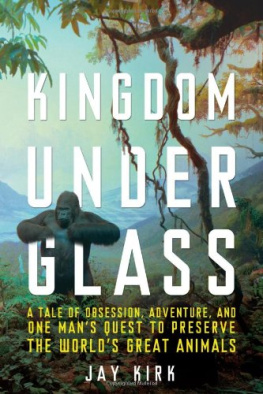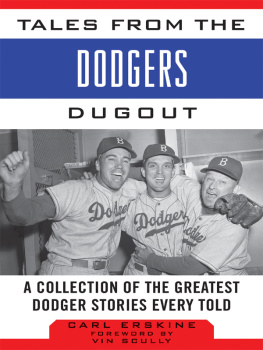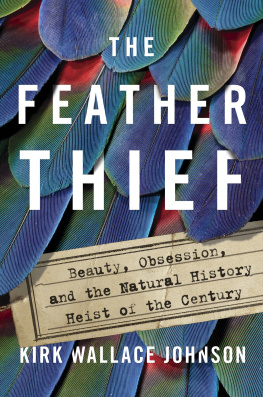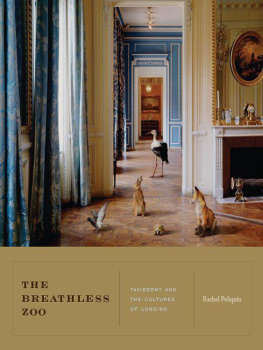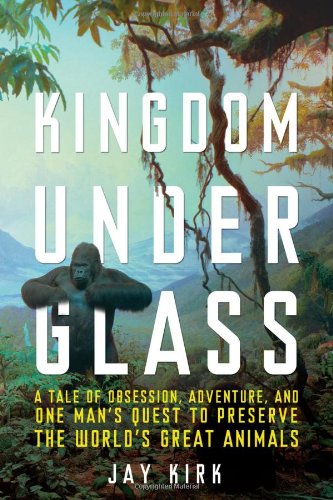My first thanks must go to my editor, Gillian Blake, who for five sometimes tumultuous years carried this book. Even when the waves got rough she never tossed it in the sea, and for that I will remain eternally grateful. Without her exquisite editorial gifts, her patience, and clarity, this book would never have been possible. Equal thanks to my agent, Heather Schroder, who first saw the promise of the book, encouraged me to delve headfirst into a few topics I knew absolutely nothing about (taxidermy, the history of Africa, zoology, and presidential biography, just to name a few). Vicki Haire gave the book a vivid and clear-eyed copyedit. I must also give dear thanks to Gregory Djanikian, Al Filreis, and Mingo Reynolds at the University of Pennsylvania, for letting me teach (without so much as a proper license), an experience that has given me immense pleasure. I only wish I could individually thank all of the students Ive had who have taught me in return. The research support provided by the always accommodating staff of the Penn libraries was unprecedented. Completing this book likewise would have been impossible without the financial support I received from the Pew Fellowship in the Arts, as well as the Pennsylvania Council on the Arts. I would like to extend personal thanks to Melissa Franklin, director of the Pew Fellowships in the Arts, as well as Sarah Biemiller, Ann Cinque, and Ellen Maher. The MacDowell Colony provided me with one of the most charmed and rewarding months of my life, where I wrote several of this books earliest chapters.
My research trip to Africa was generously underwritten by GQ magazine, even if my editor, Joel Lovell, and his boss, Jim Nelson, were under the impression I was going to Rwanda exclusively to write a story about tourism. Thanks, guys! Thanks also to Roger Hodge, my erstwhile editor at Harpers , and to John Jeremiah Sullivan, who gave me the assignment that would, inadvertently, and via the phantasmagoric charms of Puma concolor, lead to my discovery of Carl Akeley. Immeasurable thanks must be given to Penelope Bodry-Sanders, who discovered Carl Akeley long before I ever did, and who first wrote of his adventures in the only true and comprehensive biography about him. Not only her fabulous book, but the research trail she so generously left in the archives at the Explorers Club, in New York City, provided me with a veritable and unerring road map. It was at the Explorers Club where I was lucky enough to meet Claire Fleming, Ryan Haley, and Dorthea Sartain, all of whom provided the most welcome of research environments imaginable. Mickie Akeleys step-great-grandson, Jesse Page, and his wife, Liz, welcomed me into their home to pore over old diaries and rifle through trunks of safari memorabilia that still smelled of Mickies perfume, even letting me sleep in the Africa Room, where spears and shields hung on the wall. I will never forget their generosity nor Jesses amazing deep-fried turkey.
I could not possibly thank all of the librarians who helped me, but the list would have to begin with Barbara Mathe, museum archivist and head of Library Special Collections at the American Museum of Natural History, and Tom Baione, acting director. Nina Cummings has been one of my best sources from the very beginning, as well as an excellent host for my visit to the Field Museum in Chicago, probably the most fun Ive ever had on a museum field trip. I would also like to thank Kathy Connor, curator of the George Eastman House; Mary Huth, Rare Books and Special Collections, at the Rush Rhees Library, University of Rochester; and Liz Dailey at the Rochester Historical Society. Special thanks to Kate Davis for a very fruitful barter system that left me far the richertyped transcripts of Carls and Mickies diaries. Thanks also to Mark Alvey, Thomas Gnoske, Armand Esai, Christine Giannoni, and Michael Godow at the Field Museum. Stephen Rogers at the Carnegie Museum of Natural History gave me a great deal of guidance at the onset of my project, pointing me in the right directions, and introducing me to My Most Beloved Taxidermist, John Janelli, which is in noway meant to diminish all the other taxidermists who shared their time and wisdom with me, among them Bill Yox, Floyd Easterman, John Matthews, and David Schwendeman.
Special thanks to Stephen Quinn for my first guided tour of the dioramas in the African Hall, for answering numerous and sundry queries, and for his gorgeous book about the habitat dioramas, Windows on Nature, which must be bound with Bakelite. Any other coffee-table book would have long ago been demolished by such relentless ogling.
Thanks to Robert Peck at the Philadelphia Academy of Natural Sciences; Susan Otto from the Milwaukee Public Museum; Deirdre Lawrence and Tara Cuthbert of the Brooklyn Museum; Jeanette Polard and Kathy Maher of the Barnum Museum; Mike Sampson of the U.S. Secret Service; Amy Meadows, Marshall Fields archivist; David Ward from the C. G. Jung Foundation; David Pavelich, Regenstein Library, University of Chicago; and Conrad Froelich and Jacquelyn Borgeson at the Safari Museum, in Chanute, Kansas, who were always cheerful and generous with their time to a fault. Many thanks to Lucy McCann at the Bodleian Library at the University of Oxford.
I would also like to thank the New-York Historical Society; Milwaukee Historical Society; Brooklyn Public Library; the Peabody Museum at Yale; Milstein Division of United States History, Local History & Geneaology, at the New York Public Library; Saint Thomas Historical Society, Ontario; Saint Thomas Public Library; Elkins County Railway Museum, West Virginia; Rochester Public Library; National Railway Historical Society; the Audubon Society; and the World Wildlife Fund.
For encouragement, for inspiration, for answering the weirdest of queries, for giving me a boost at some point along the way, countless individuals are to thank, but the briefest of lists would have to include: Lauren Arens, Adam Bates, Jessica Baumgardner, Sven Birkerts, Ward Bowen, Meredith Broussard, Claire Busse, Lisa Carlson, Robert Claus, Susan C. Colby, Jamie Farrell, Bridgetta Bourne-Firl, Virginia Foletta, Walton Ford, Dave Foreman, Sue Frederick, Bob Gallagher (in memoriam), Jack Gantos, Bernard Goffinet, David R. Godine, Joe Greenwald, J. C. Hallman, Jack Hitt, Dick Houston, Melissa Ierlan, Pascal Imperato, Alan Isselhard, Bob Iveson, Bob Jones, Sam Katz, Tim Kirk, Kenneth Lacovara, Lewis Lapham, Bill Lattin, Todd Lester, Darren Mann, Michael Martin, Toby Lester, Michael and Jennifer McGloin, Nicholas Monte-marano, Susan Morse, Jason Moser, Ernest Ntagozera (in memoriam),Emily Nussbaum, David Pearce, Mark Polizzotti, Pamela Polston, Jason Ross, Fred Scherer, Peter Schwartz, Jeff Sharlet, Don Silver, Phil Sirois, Mary E. Smith, Carol Cioffi Smith, Steve Steiger, Zoe Strauss, Thomas Swearingen, Jack Tabor, Alison True, Brendan Vaughan, Greg Veis, Alisa Volkman, Calvin Wang, David Warner, Bill Wasik, Art Winslow, Holly Wofford, Margaret Wood, Sarah Zar, and Douglas Zinn.
Thanks to Quinn Eli for reading chapters, for being the most insightful human being on the planet, for being the dearest of friends; and to Thomas Devaney, for your vision, your poetry, your grace and friendship, for listening to me endlessly plot. To Evan Rossheim and Janet Hoffman, the best neighbors a person could ever dream of having, with special thanks to Janet for reading several chapters and for her thoughtful suggestions. Very special thanks to Beth Kephart for your steadfast friendship, your endless support and enthusiasm for this project, and for your empathy for a fellow writers anxieties. Thanks too for the glass elephant eyeit has been a most auspicious talisman.

